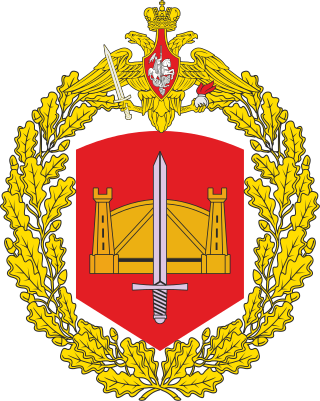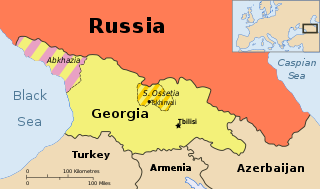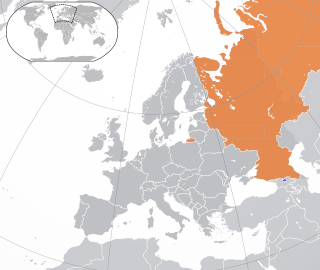
South Ossetia, officially the Republic of South Ossetia or the State of Alania, is a partially recognised landlocked state in the South Caucasus. It has an officially stated population of just over 56,500 people (2022), who live in an area of 3,900 square kilometres (1,500 sq mi), with 33,000 living in the capital city, Tskhinvali.

Tskhinvali or Tskhinval is the capital of the disputed de facto independent Republic of South Ossetia, internationally considered part of Shida Kartli, Georgia. Tskhinvali Region, known historically as Samachablo, was always part of the Georgian state as a single military and administrative entity. It is located on the Great Liakhvi River approximately 100 kilometres (62 mi) northwest of the Georgian capital Tbilisi.

The Georgian–Ossetian conflict is an ethno-political conflict over Georgia's former autonomous region of South Ossetia, which evolved in 1989 and developed into a war. Despite a declared ceasefire and numerous peace efforts, the conflict remained unresolved. In August 2008, military tensions and clashes between Georgia and South Ossetian separatists erupted into the Russo-Georgian War. Since then, South Ossetia has been under a de-facto Russian control.

The 1991–1992 South Ossetia War was fought between Georgian government forces and ethnic Georgian militias on one side and the forces of South Ossetian separatists and Russia on the other. The war ended with a Dagomys Agreement, signed on 24 June 1992, which established a joint peacekeeping force and left South Ossetia divided between the rival authorities.
Joint Control Commission for Georgian–Ossetian Conflict Resolution (JCC) was a peacekeeping organization, operating in South Ossetia and overseeing the joint peacekeeping forces in the region. It was disbanded on October 10, 2008.

The 58th Guards Combined Arms Army is an army of the Russian Ground Forces, headquartered at Vladikavkaz, North Ossetia-Alania, within Russia's Southern Military District. It was formed in 1941 as part of the Soviet Union's Red Army and has been part of the Russian Army since 1995. It has the Military Unit Number (в/ч) is 47084.
An international diplomatic crisis between Georgia and Russia began in 2008, when Russia announced that it would no longer participate in the Commonwealth of Independent States economic sanctions imposed on Abkhazia in 1996 and established direct relations with the separatist authorities in Abkhazia and South Ossetia. The crisis was linked to the push for Georgia to receive a NATO Membership Action Plan and, indirectly, the unilateral declaration of independence by Kosovo.

The 2008 Russo-Georgian War was a war between Russia and the Russian-backed self-proclaimed republics of South Ossetia and Abkhazia against Georgia. The war took place in August following a diplomatic crisis between Russia and Georgia, both formerly constituent republics of the Soviet Union. The fighting took place in the strategically important South Caucasus region. It is regarded as the first European war of the 21st century.

The Battle of Tskhinvali was a fight for the city of Tskhinvali, the capital of the self-proclaimed Republic of South Ossetia. It was the only major battle in the Russo-Georgian War. Georgian ground troops entered the city on early 8 August 2008. After the three-day fierce fighting with South Ossetian militia and Russian troops, Georgian troops finally withdrew from the city on the evening of 10 August. By 11 August, all Georgian troops had left South Ossetia and Russian forces advanced into undisputed Georgia facing no resistance.

The Russo-Georgian War broke out in August 2008 and involved Georgia, Russian Federation, South Ossetia and Abkhazia.

The Russo-Georgian War included an extensive information war. Russia spread disinformation to discredit Georgia, Ukraine and the United States even after the end of armed hostilities.

Russia–South Ossetia relations refers to the bilateral relationship between Russia and the Republic of South Ossetia, a disputed region in the South Caucasus, located on the territory of the South Ossetian Autonomous Oblast within the former Georgian Soviet Socialist Republic.

Abkhazia–South Ossetia relations are bilateral foreign relations between the Republic of Abkhazia and the Republic of South Ossetia, whose international status is disputed – they are both considered part of Georgia by the majority of the world's states.

The Russo-Georgian War had a huge humanitarian impact on the lives of civilians. In the aftermath of the war, ethnic Georgians were expelled from South Ossetia and most of the Georgian villages were razed.

The 2008 war between Russia and Georgia created controversy, with both sides blaming each other for starting the war.

Anatoly Ilyich Bibilov is a South Ossetian military officer, was the fourth president of South Ossetia. He succeeded Leonid Tibilov as president on 21 April 2017 to 24 May 2022, following his election victory, but was defeated by Alan Gagloev in the 2022 election.

Independence Day or Republic Day is the main state holiday in the partially recognized Republic of South Ossetia. This date is celebrated on September 20. It commemorates South Ossetia's declaration of independence from the Georgian SSR in 1990, and the country's recognition as a sovereign state by Russia in 2008.
The Ministry of Defense of South Ossetia is a government agency of the partially recognized Republic of South Ossetia. It is the executive body in implementing defense policies in of the Armed Forces of South Ossetia. The current Minister of Defense is Colonel Inal Sabanov.

The 4th Guards Military Base is a sizable overseas military base of the Russian Armed Forces stationed in the disputed territory of South Ossetia. Russia considers South Ossetia to be an independent state and justifies its military deployment in the area by an intergovernmental agreement, while Georgia considers the entity as its territory occupied by Russia.

Nykhaz is a political party in South Ossetia founded in 2013 by supporters of Independent president Leonid Tibilov. Its members and supporters are referred to as Nykhasovites in local media.


















